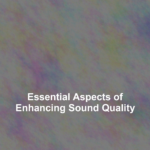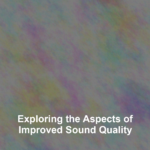As you wade through the vast ocean of sound, youG??ll find that improving audio quality is akin to refining a precious gemG??itG??s both an art and a science. YouG??re well aware that clarity, depth, and fidelity are the cornerstones of exceptional sound, but achieving these elements isnG??t just a matter of cranking up the volume.
It involves a symphony of factors, from the acoustics of your environment to the intricacies of your audio equipment. Mastering the nuances of recording techniques and optimizing playback settings play a pivotal role, as does the often-overlooked importance of regular maintenance.
YouG??re standing at the threshold where technical knowledge meets practical application, and itG??s crucial to understand how these aspects can transform the raw, unpolished sounds into an experience that resonates with crystal-clear perfection. LetG??s explore how you can elevate your auditory landscape to levels that not only meet but surpass the standard expectations.
The Role of Acoustics
Acoustics play a pivotal role in shaping the sound quality you experience, whether itG??s in a concert hall, recording studio, or your own living room. Every space youG??re in interacts with sound differently, bouncing it around or absorbing it. When youG??re keen on achieving the perfect audio ambiance, youG??ve got to consider the roomG??s acoustical properties.
Hard surfaces reflect sound, causing echoes and reverberation that can muddy your music or dialogue. ThatG??s why youG??ll often see those foam panels in recording studiosG??theyG??re there to dampen the bounce and give you that crisp, clean sound. YouG??re not limited to professional gear, though. Even simple tweaks like adding rugs, bookshelves, or curtains can significantly improve your spaceG??s sound quality by reducing unwanted reflections.
On the flip side, if a roomG??s too G??deadG?? or non-reflective, it can feel unnaturally quiet, making sound seem flat or lifeless. ItG??s all about balance. You want enough absorption to prevent echoes but enough reflection to keep the sound lively.
Audio Equipment Essentials
While considering a roomG??s acoustical properties is crucial, the quality of your audio equipment plays an equally important role in experiencing superior sound. DonG??t settle for subpar gear and expect your roomG??s acoustics to compensate. You need high-quality components to capture the full range of audio nuances.
Start with a reliable pair of speakers or headphones. TheyG??re your direct link to the music or audio content, so their performance is non-negotiable. If youG??re choosing speakers, consider their size and power relative to your listening space. Headphones should offer comfort, excellent frequency response, and minimal distortion.
Your amplifier is the heart of your system, supplying power and detail to your speakers. Make sure it has enough wattage to drive your speakers effectively without strain. A low signal-to-noise ratio is keyG??you want all the music, none of the hum.
DonG??t skimp on your source either. Whether itG??s a turntable, CD player, or digital audio player, it should provide clean, unaltered sound. If youG??re streaming, opt for services that offer high-resolution audio.
Lastly, cables matter more than you might think. Quality cables can reduce interference and preserve sound integrity. You donG??t have to spend a fortune, but avoid the cheapest options. Sound quality isnG??t just about the big pieces; the details count too.
Recording Techniques Mastery
Mastering recording techniques is essential for capturing audio thatG??s both clear and faithfully representative of the original sound. YouG??ll want to delve into various mic placements, understand the acoustics of your recording space, and get a solid grasp on signal flow. ItG??s not just about hitting record; itG??s about setting the stage for the highest quality capture.
Start by experimenting with microphone positions. YouG??ll find that even a slight change can dramatically affect the sound. Close miking instruments can yield a full, intimate sound, while a room mic setup captures the ambiance and space, providing a more live feel. DonG??t forget to consider the polar patterns of your microphones; knowing whether to use a cardioid, omnidirectional, or figure-8 mic can make or break your recording.
Next, youG??ve got to tackle the room. If itG??s not treated properly, youG??ll likely pick up unwanted reverb or echoes. Use diffusers and absorbers to control reflections and bass traps to manage low frequencies. YouG??re not just recording a voice or an instrumentG??youG??re capturing the environment around it.
Lastly, understand your signal chain. High-quality cables, preamps, and converters ensure that the pristine sound youG??re capturing is whatG??s being recorded. Remember, every component matters. YouG??re the maestro of this symphony of gear and technique, so make every note count.
Optimizing Playback Settings
After honing your recording techniques, itG??s crucial to focus on optimizing playback settings to ensure listeners experience the full richness of your audio work. YouG??ll want to dive into your playback deviceG??s settings, whether itG??s a sophisticated audio system or your smartphoneG??s music app. Start by adjusting the equalizer (EQ). Tailoring the balance of frequencies can dramatically enhance the listening experience. DonG??t just crank up the bass; consider the genre and mood of the track when deciding which frequencies to boost or cut.
Next, look at the bit rate and sample rate settings. If storage isnG??t an issue, go for higher rates to maintain the integrity of your sounds. Remember, though, that some devices mightnG??t support the highest settings, so find a sweet spot compatible with most playback equipment.
Pay attention to the environment where your audio is typically played. Adjust settings that cater to spaces, whether itG??s a quiet room or a noisy gym. Also, donG??t forget to test your audio on different devices and earphones, as what sounds good on one may not translate well to another.
Regular Maintenance Practices
To keep your sound system performing at its best, regular maintenance is essential. You wouldnG??t drive your car for years without an oil change; similarly, donG??t neglect your audio equipment. Dust and grime can seriously degrade your systemG??s performance. So, youG??ll want to dust your components regularly, using a soft, dry cloth. Avoid harsh chemicals or abrasive materials that could damage the surfaces or internals.
Check your cables and connections periodically, too. Loose or corroded connections can cause static or signal loss, impacting sound quality. If youG??re using analog connections, unplugging and replugging them can help maintain a clean contact. For digital interfaces, ensure the ports are free from dust and the cables arenG??t frayed or kinked.
DonG??t forget about the speakers. Keep the cones dust-free, and if you have removable grilles, take them off and clean them gently. Also, make sure your speakers are placed away from walls or corners where dust tends to accumulate.
Conclusion
YouG??ve now seen how enhancing sound quality is multifaceted.
It starts with mastering acoustics, selecting the right audio gear, and honing your recording skills.
DonG??t overlook the importance of tweaking playback settings for the best experience.
And remember, keeping your equipment well-maintained is crucial.
Embrace these elements, and youG??ll elevate your audio game.
ItG??s your journey to crystal-clear soundG??enjoy every step and every note along the way.










